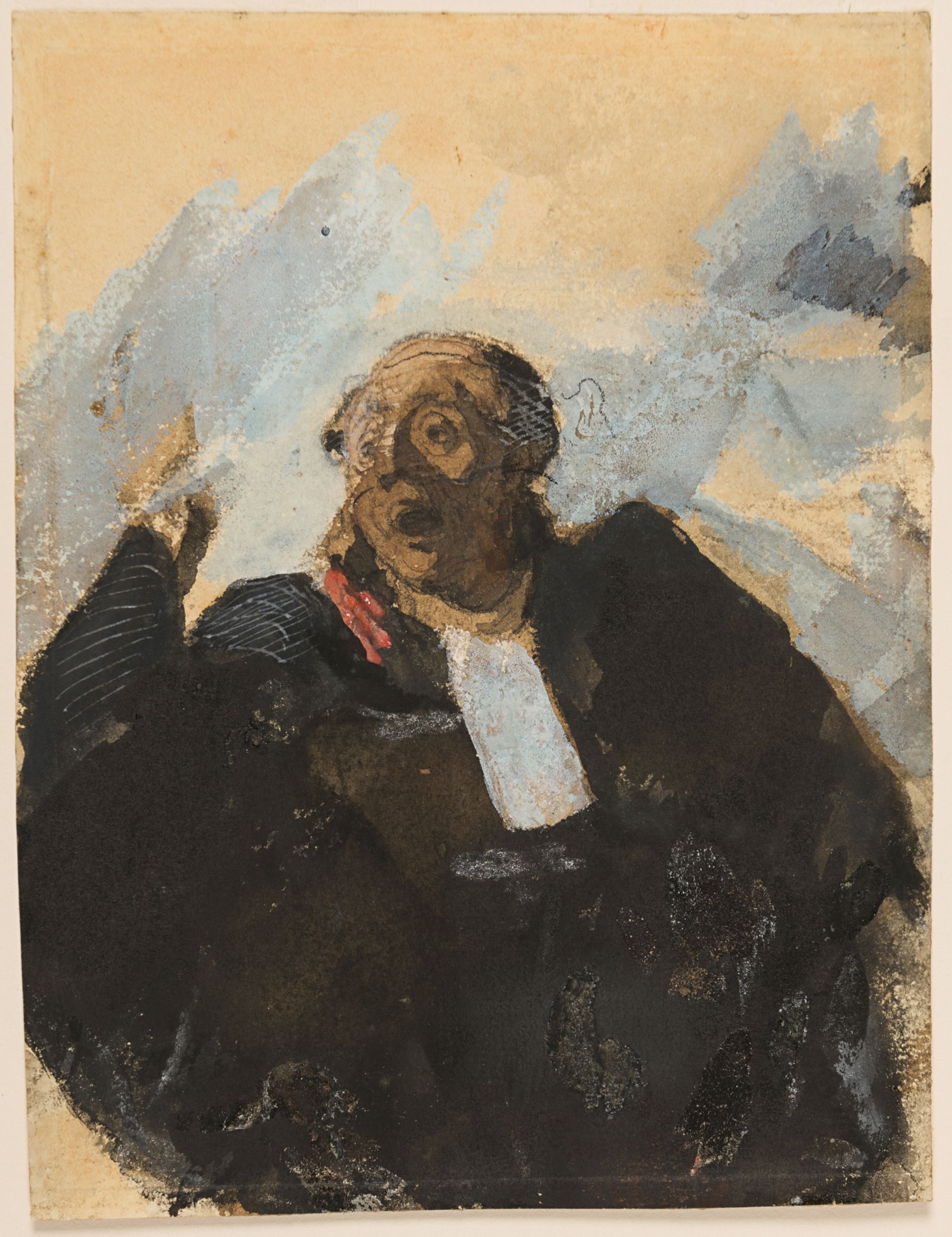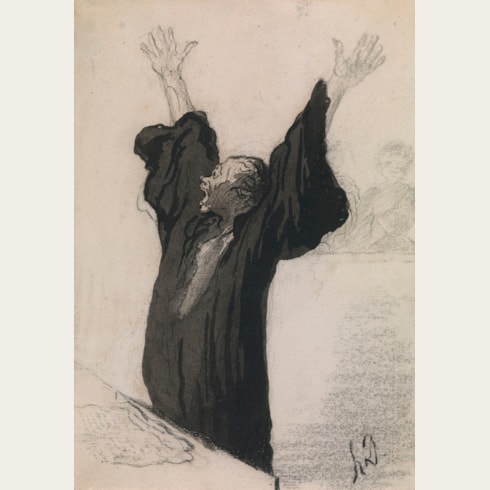Honoré DAUMIER
(Marseille 1808 - Valmondois 1879)
The Lawyer
Watercolour and gouache, over an underdrawing in black chalk.
Inscribed H Daumier / Hier(?) biseau anglais - / [?] on the verso.
171 x 131 mm. (6 3/4 x 5 1/8 in.)
Inscribed H Daumier / Hier(?) biseau anglais - / [?] on the verso.
171 x 131 mm. (6 3/4 x 5 1/8 in.)
In the 1830s Honoré Daumier became a regular visitor to the Palais de Justice in Paris, and he portrayed scenes from the law courts in around two hundred lithographs, drawings, watercolours and paintings over the next thirty years. As Colta Ives has noted, ‘Lawcourts, which were the centers of great influence and authority in nineteenth-century France, aroused the attention of Daumier to an exceptional degree. In fact, no other artist has ever been quite so fascinated by the legal profession or has proclaimed its endemic weaknesses so vividly…His depictions of lawyers and court drama grew stronger in design and larger in meaning as he progressed from detailing specific personages and events to presenting simpler, generalized images of one or two figures symbolic of the profession and its practices…the fame of his prints was such that a market existed for drawings and watercolors which the artist produced for collectors, mainly during the 1860s…Daumier’s particular genius is evident in the stunning and disciplined clarity of his images. The artist never became mired in detail or narratives that required explanation, but instead concentrated on defining character through incisive description.’
The first owner of the present sheet was the French writer and art critic Roger Marx (1859-1913), one of the earliest collectors of Daumier’s drawings. As his son, the art historian Claude Roger-Marx, later recalled of his father’s collection of drawings by Daumier: ‘From my early childhood, I have lived in daily intimacy with Daumier’s exciting world. At a time when he was still considered only a “humourist”, my father was able to acquire two cardboard boxes of drawings and sketches that had miraculously escaped destruction. These first thoughts, like the painted studies, were so disregarded at the time that it is said that almost all of them were thrown away by his widow in the trash. Between Daumier and myself all distances were removed. I tried to forget everything that others had written about him in order to find myself free of all topicality, served by an inexhaustible imagination, an extraordinary visual memory, one to one with his ardour, his sadness too…’
Following his death in December 1913, Roger Marx’s collection was dispersed in five auctions held the following year. The present sheet was included in one of these sales, in May 1914, when it was acquired by the collector and pioneering Islamic art dealer Dikran G. Kelekian (1868-1951). Of Armenian descent, Kelekian had established his successful business in antiquities in Constantinople in 1892, and later opened galleries in Cairo, Paris, New York and London. Sometime in the 1910s Kelekian began collecting works by modern French artists, especially of the Impressionist and Post-Impressionist schools, and by 1920 had amassed an impressive collection that included works by Pierre Bonnard, Paul Cézanne, André Derain, Henri Matisse, Pablo Picasso, Henri de Toulouse-Lautrec and Edouard Vuillard.
The first owner of the present sheet was the French writer and art critic Roger Marx (1859-1913), one of the earliest collectors of Daumier’s drawings. As his son, the art historian Claude Roger-Marx, later recalled of his father’s collection of drawings by Daumier: ‘From my early childhood, I have lived in daily intimacy with Daumier’s exciting world. At a time when he was still considered only a “humourist”, my father was able to acquire two cardboard boxes of drawings and sketches that had miraculously escaped destruction. These first thoughts, like the painted studies, were so disregarded at the time that it is said that almost all of them were thrown away by his widow in the trash. Between Daumier and myself all distances were removed. I tried to forget everything that others had written about him in order to find myself free of all topicality, served by an inexhaustible imagination, an extraordinary visual memory, one to one with his ardour, his sadness too…’
Following his death in December 1913, Roger Marx’s collection was dispersed in five auctions held the following year. The present sheet was included in one of these sales, in May 1914, when it was acquired by the collector and pioneering Islamic art dealer Dikran G. Kelekian (1868-1951). Of Armenian descent, Kelekian had established his successful business in antiquities in Constantinople in 1892, and later opened galleries in Cairo, Paris, New York and London. Sometime in the 1910s Kelekian began collecting works by modern French artists, especially of the Impressionist and Post-Impressionist schools, and by 1920 had amassed an impressive collection that included works by Pierre Bonnard, Paul Cézanne, André Derain, Henri Matisse, Pablo Picasso, Henri de Toulouse-Lautrec and Edouard Vuillard.
Born in Marseille but raised in Paris, Honoré Daumier was almost never to leave the city, and made its people the subject of much of his work. Although he attended life drawing classes at the Académie Suisse, he had little formal artistic training and was, for the most part, self-taught. He began his career as an illustrator and lithographer, providing images and political caricatures for newspapers and magazines such as La Silhouette, La Caricature and, most famously, Le Charivari. He soon established a formidable reputation as a caricaturist. Over the course of his life, Daumier produced over four thousand lithographs and some eight hundred drawings and watercolours. The drawings were mainly done during periods in his career – in the late 1840s and early 1850s, and again in the 1860s - when the artist’s time was not completely devoted to his commercial work as a lithographer. In the 1860s, for example, when he was temporarily laid off by Le Charivari, Daumier produced a number of highly finished and elaborate watercolours to be sold to collectors.
As a draughtsman, Daumier tended to depict a handful of favourite themes, notably carnival performers, women and children, people on trains and in railway stations, and the law courts. Working in chalk, charcoal, watercolour, pen and ink and wash, he created both finished drawings and watercolours for sale, as well as sketches or studies and quick ‘notes’. As the critic Claude Roger-Marx wrote of the artist, ‘When Daumier drew to please himself and without thought of a purchaser, it was nearly always with the pen or with charcoal; sometimes with a Conté crayon, very seldom with a lead pencil. To an expansive genius, driven by the power of his imagination, charcoal gives the greatest scope, enabling him to pass in an instant from the most velvety black to silvery grey, to stress contrasting values, to make the most of the qualities of shimmering light which transform the charcoal powder into a modest form of pastel…The pen in Daumier’s inspired fingers was no less rapid: we may follow its course across the surface of the smooth laid paper which he used for choice. It runs lightly, leaving furrows as though seared by fire, and, like the charcoal, it never fails to achieve a miracle...’ Daumier’s drawings are very rarely dated and are often unsigned, and only a very few were exhibited in his lifetime.
As a draughtsman, Daumier tended to depict a handful of favourite themes, notably carnival performers, women and children, people on trains and in railway stations, and the law courts. Working in chalk, charcoal, watercolour, pen and ink and wash, he created both finished drawings and watercolours for sale, as well as sketches or studies and quick ‘notes’. As the critic Claude Roger-Marx wrote of the artist, ‘When Daumier drew to please himself and without thought of a purchaser, it was nearly always with the pen or with charcoal; sometimes with a Conté crayon, very seldom with a lead pencil. To an expansive genius, driven by the power of his imagination, charcoal gives the greatest scope, enabling him to pass in an instant from the most velvety black to silvery grey, to stress contrasting values, to make the most of the qualities of shimmering light which transform the charcoal powder into a modest form of pastel…The pen in Daumier’s inspired fingers was no less rapid: we may follow its course across the surface of the smooth laid paper which he used for choice. It runs lightly, leaving furrows as though seared by fire, and, like the charcoal, it never fails to achieve a miracle...’ Daumier’s drawings are very rarely dated and are often unsigned, and only a very few were exhibited in his lifetime.
Provenance
Roger Marx, Paris
His posthumous sale, Paris, Galerie Manzi, Joyant, 11-12 May 1914, lot 119 (L’Avocat. En robe, tête découverte, il pérore dans le feu de la plaidoirie. Fond blanc, noir gris et bleu. Dessin rehaussé. Haut., 16 cent.; larg., 12 cent.)
Dikran Garabed Kelekian, Paris and New York
Private collection, New York
Anonymous sale, New York, Parke-Bernet Galleries, 13 May 1953, lot 16
Fine Arts Associates, New York
Private collection, America, in 1967
Grace Borgenicht, New York
Private collection
Davis and Langdale, New York
David Dufour, New York
Anonymous sale, Paris, Artcurial, 28 March 2012, lot 225
Gérard Lhéritier (Aristophil), Nice.
His posthumous sale, Paris, Galerie Manzi, Joyant, 11-12 May 1914, lot 119 (L’Avocat. En robe, tête découverte, il pérore dans le feu de la plaidoirie. Fond blanc, noir gris et bleu. Dessin rehaussé. Haut., 16 cent.; larg., 12 cent.)
Dikran Garabed Kelekian, Paris and New York
Private collection, New York
Anonymous sale, New York, Parke-Bernet Galleries, 13 May 1953, lot 16
Fine Arts Associates, New York
Private collection, America, in 1967
Grace Borgenicht, New York
Private collection
Davis and Langdale, New York
David Dufour, New York
Anonymous sale, Paris, Artcurial, 28 March 2012, lot 225
Gérard Lhéritier (Aristophil), Nice.
Literature
Erich Klossowski, Honoré Daumier, Munich, 1923, p.102, no.177Q; K. E. Maison, Honoré Daumier: Catalogue Raisonné of the Paintings, Watercolours and Drawings, Vol.II, London, 1967, p.209, no.630, illustrated pl.237.








